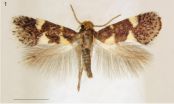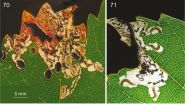(Press-News.org) Since 2011 an unknown leafmining moth was observed in table grape orchards and often in large numbers in the Paarl region of the Western Cape (South Africa).
Although the effect of the leafmines on the grape vine itself appears to be limited, collateral damage may be more serious, especially when larvae descend from the vine canopy to form a dense curtain of suspended larvae. A new study published in ZooKeys looks into the morphology and biology of the potential pest.
Although the leafminer had been seen before in South Africa, it proved impossible to find its name.
Entomologist Henk Geertsema, professor at Stellenbosch University turned for help to Erik van Nieukerken, researcher at Naturalis Biodiversity Center (Leiden, the Netherlands), who had just described a similar invading leafmining moth from Italian vineyards.
Both the new mysterious species and the one recently described from Italy belong to the family of the shield bearing leafminers (Heliozelidae), a moth family that has been poorly studied globally. After some consultations the two scientists concluded that the South African moth appeared to be an unknown species of this family, closely related to the European Holocacista rivillei.
Study of the collections of leafminers, assembled by the late Lajos Vári of the Ditsong Natural History Museum (formerly the Transvaal Museum) in Pretoria showed that South Africa in fact has a rich, but unknown fauna of this moth family, of which several species feed on wild grapes or bush grapes (Rhoicissus species) throughout southern Africa.
By detailed taxonomic study it was shown that the grape feeding species had previously been collected on wild grape near Wilderness, Western Cape. It is believed that it shifted from this original host to cultivated grapes in the wine and tablegrape producing areas of the Western Cape.
The unknown insect is now described as Holocacista capensis. It is a tiny moth with a wingspan of ca. 4 mm, with some silvery white spots on its wings. The eggs are inserted in the leaf, and the larva eats a tunnel inside the leaf, creating the so-called leafmine.
The full-grown larva subsequently cuts out a shield from the leaf, leaving behind characteristic holes. The larva is able to move around in this shield and usually descends by a silken thread to attach it to a trunk, trellis, leaf or even on grapes.
The larva pupates inside the shield, and moths emerge a few weeks later. In winter the larva it hibernates in the shield and the first moths appear in September. Moths are seen from September until early May. There are several generations annually, with peak numbers in February and March.
In fact the first records of this moth from grapevines in Pretoria date back to 1950. At present, the moth is widespread in the grape vine regions of the Western Cape, but mainly restricted to the region south of the Cape Fold Mountain range. In the northern part of South Africa, it occurs in high population numbers in the table grape region at Brits, East of Pretoria.
The effect of the leafmines on the grape vine itself appears to be limited, but collateral damage may be more serious, especially when larvae descend from the vine canopy to form a dense curtain of suspended larvae.
Taxonomic knowledge of these insects in South Africa is often insufficient, and the discovery of a pest often leads to extensive taxonomic research.
INFORMATION:
Original Source:
van Nieukerken EJ, Geertsema H (2015) A new leafminer on grapevine and Rhoicissus (Vitaceae) in South Africa within an expanded generic concept of Holocacista (Insecta, Lepidoptera, Heliozelidae). ZooKeys 507: 41-97. doi: 10.3897/zookeys.507.9536
A team of Tel Aviv University and UCLA astronomers have discovered a remarkable cluster of more than a million young stars are forming in a hot, dusty cloud of molecular gases in a tiny galaxy very near our own.
The star cluster is buried within a massive gas cloud dubbed "Cloud D" in the NGC 5253 dwarf galaxy, and, although it's a billion times brighter than our sun, is barely visible, hidden by its own hot gases and dust. The star cluster contains more than 7,000 massive "O" stars: the most brilliant stars extant, each a million times more luminous than our sun.
"Cloud ...
Simon Fraser University PhD graduate Maryam Sadeghi will unveil MoleScope™, an innovative hand-held tool that uses a smartphone to monitor skin for signs of cancer, at the World Congress of Dermatology conference in Vancouver June 9-13.
Sadeghi has spent three years transitioning from academic research to her start-up venture, MetaOptima Technology Inc. MoleScope™, the company's inaugural product, which enables people to monitor their moles and skin health, share images with family and healthcare providers and eventually, connect skin specialists with people ...
Two young researchers working at the MIPT Laboratory of Nanooptics and Plasmonics, Dmitry Fedyanin and Yury Stebunov, have developed an ultracompact highly sensitive nanomechanical sensor for analyzing the chemical composition of substances and detecting biological objects, such as viral disease markers, which appear when the immune system responds to incurable or hard-to-cure diseases, including HIV, hepatitis, herpes, and many others. The sensor will enable doctors to identify tumor markers, whose presence in the body signals the emergence and growth of cancerous tumors.
The ...
Two years ago, the Immunology of Diabetes Research Group at the Germans Trias Research Institute (at Universitat Autònoma de Barcelona - Campus of International Excellence Sphere) reported a new experimental immunotherapy that prevented the onset of Type 1 Diabetes in mice predisposed to the disease. This work led to more studies with the support of the Spanish Government, Catalan Government and private patrons with a keen interest in it. Thanks to this, the article published today in PLOS ONE describes a new step towards the creation of a vaccine, which in the medium-term ...
June 9, 2015 - New approaches, based on body mass index (BMI) or other simple measures, are needed to improve assessment of obesity in adolescents with physical disabilities, reports a paper in the American Journal of Physical Medicine & Rehabilitation, the official journal of the Association of Academic Physiatrists. The journal is published by Wolters Kluwer.
Obesity is a major problem in children and adolescents with mobility limitations, but standard assessments tend to underestimate it, according to the new research by Brooks C. Wingo, PhD, of University of Alabama ...
Nagoya, Japan - A team of chemists and biologists at the Institute of Transformative Bio-Molecules (ITbM), Nagoya University have succeeded in finding new molecules that change the circadian rhythm in mammals by applying synthetic chemistry methods, which makes use of highly selective metal catalysts.
Most living organisms have a biological clock with an approximately 24-hour circadian rhythm, which regulates important body functions such as sleep/wake cycles, hormone secretion, and metabolism. Disruption of the circadian rhythm by genetic mutations and environmental ...
LOS ANGELES (JUNE 8, 2015) - The witness on the stand says he saw the accused at the scene of the crime. Is he sure? How sure? The jury's verdict could hinge on that level of certainty.
Many decisions we make every day are influenced by our memories and the confidence we have in them. But very little is known about how we decide whether we can trust a memory or not.
A new Cedars-Sinai study provides some of the answers. Researchers have identified a unique set of neurons in the medial temporal lobe, an area of the brain where memories and memory-based decisions are ...
The use of camera traps -- remote automatic cameras triggered by heat or motion -- has revolutionized wildlife ecology and conservation research. But the large number of images generated through the traps creates the problem of categorizing and analyzing all the images.
For a recent project conducted in the Serengeti National Park, Alexandra Swanson, turned to another relatively new technology -- a citizen science platform. The Snapshot Serengeti project asked non-scientist volunteers to review 1.2 million sets of images. A description of the project, 'Snapshot Serengeti, ...
A variety of factors including questions about risk and reluctance to offend patients limits clinician willingness to prescribe a potentially life-saving medication that counteracts the effects of an opioid overdose, according to a Kaiser Permanente Colorado study published today in the Journal of General Internal Medicine.
The number of fatal overdoses from opioid medications has quadrupled in the U.S. since 1999. According to the Centers for Disease Control and Prevention (CDC), each day 44 people die of prescription painkiller overdoses. In the event of an overdose, ...
American physicians with waivers allowing them to provide office-based medication-assisted buprenorphine treatment to patients addicted to opioids were able to increase potential access to effective medication-assisted treatment by 74 percent from 2002 to 2011, according to a new RAND Corporation study.
Published in the June issue of the journal Health Affairs, the study shows that the increased number and geographic distribution of physicians obtaining waivers to prescribe buprenorphine has widened potential access to effective treatment for those with addiction to heroin ...




